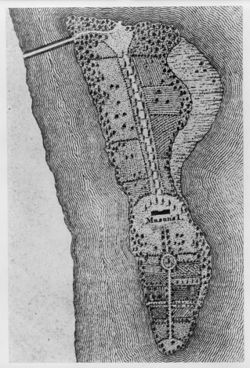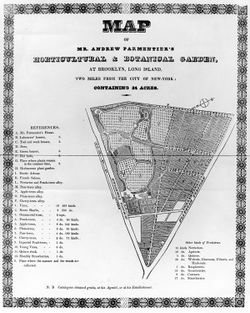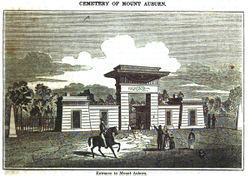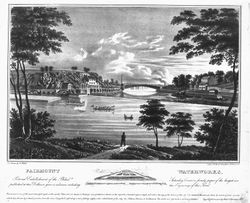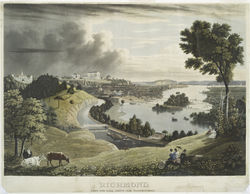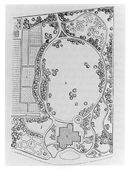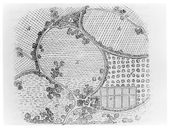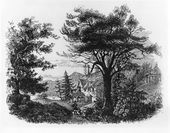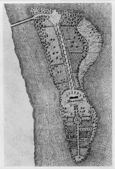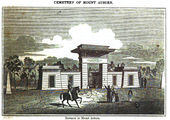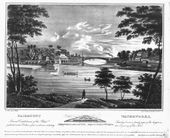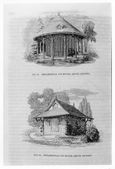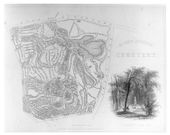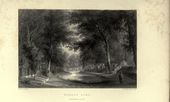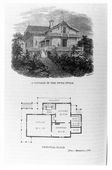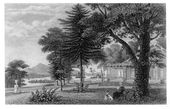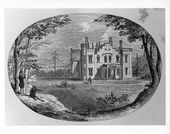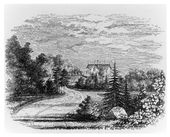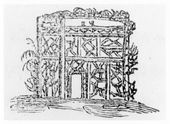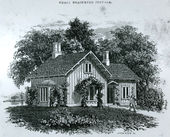Picturesque
History

The picturesque is an aesthetic category derived from the idea of designing landscapes to look like pictures. The picturesque was at its height in Britain around the turn of the nineteenth century, though its development began much earlier and it is still in use today. In American landscape discourse, the term "picturesque" had two important uses. The first referred to a garden style with specific compositional components detailed by theorists such as Thomas Whately and A. J. Downing. The picturesque also came to be understood as a visual effect achieved by the incorporation of natural and designed landscape elements into a prospect or view. This second sense is clear in J. C. Loudon's 1826 claim that a view was picturesque if "it would form a tolerable picture" when painted (view citation). This use of the term was used frequently in travelers' descriptions of towns, settlements, or gardens. Downing later echoed Loudon when he wrote that "the picturesque is nature or art obeying the same laws rudely" (1849) (view citation). It is evident that during their historical development, both senses of this term, as either a style or a visual effect, were frequently used simultaneously. In addition, in many cases the term "picturesque" served as an effective expression meaning simply an attractive or pleasing scene, as in the case of William Bartram's romantic and evocative descriptions of his travels in the south (1792) (view citation). The goal of the picturesque was to re-create in the garden the experience of the natural landscape. The chief characteristics of the picturesque were surprise and variety, in contrast to the effects of terror and awe associated with the sublime. These characteristics were defined by the theorists Whately and William Gilpin, whose treatises were well known in America. At Mount Vernon, Rev. Manasseh Cutler reported in 1802 that the picturesque effect was enhanced by "coming out of a thick wood, and the sudden and unexpected manner in which it was seen," underscoring the importance of surprise to the picturesque effect (view citation). Similarly, sinuous routes through the garden afforded a "continual change of scenery." In reference to his picturesque plantations, Downing claimed that the effect depended upon "intricacy and irregularity."[1]
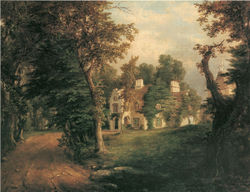
In A New and Complete Dictionary of Arts and Sciences (1816), G. Gregory insisted that the picturesque garden was possible only in properties that exceeded twenty acres; smaller lots were considered ridiculous for such a function. He thus defines the picturesque garden as part of the larger designed landscape, a portion apart from the house, and extensive and often synonymous with "park" (view citation). Any part of a designed landscape, however, could be produced in the picturesque mode, even the ornamental farm as illustrated by Downing [Fig. 1].
The concept of the picturesque was critical to Downing's approach and a continuous theme in his Treatise on the Theory and Practice of Landscape Gardening (1849). Downing defined the picturesque as a style distinct from the beautiful mode of design, but considered both varieties of the modern or natural style of landscape gardening: the "Beautiful" expressed simple and flowing forms, whereas the "Picturesque" had striking, irregular and "pointed" forms. He illustrated the latter term with cottage houses set on relatively modest lots [See Fig. 17]. The picturesque style, according to Downing, was achieved not by size (contrary to Gregory's definition), but by shapes and outlines of trees, architecture, and grounds. For Downing, the term represented primarily a rejection of all regular and geometric forms in landscape design.
Instructions for laying out the picturesque garden were found in garden literature such as the Horticultural Register, which stated in 1837 that the picturesque was a "facsimile imitation of natural scenery" (view citation). In his treatise, Downing advocated that trees should stand in irregular groups not in straight rows, and paths and borders should be winding or serpentine, adapting to the natural inequalities of the surface. Several writers recommended that any sign of artifice should be disguised.

American scenery, according to Downing and his contemporaries, was a place where, he wrote in 1850, "the wildness or grandeur of nature triumphs strongly over cultivated landscape," and ultimately harmonizes with the boldly varied picturesque style (). The ingredients of Downing's picturesque included an architecture of projecting profiles and bold outlines, specific vegetation, such as larch trees, and planting schemes of irregular groups. The desired effect could be achieved, according to Downing, at little cost, even on small properties such as farms. He illustrated the picturesque garden in his Treatise with winding lanes, irregular groups of trees, and untrimmed hedges giving a less formal, and a more free and natural air.
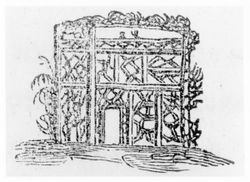
Numerous representations and descriptions of designed landscapes emphasized the picturesque aesthetics of the site, exemplified by both image and text of Washington Irving's Sunnyside [Fig. 2]. Gardens laid out with picturesque features have been documented from the 1740s in the British colonies, in such places as Henry Middleton's seat, Middleton Place, and William Middleton's plantation, Crowfield, both near Charleston, S.C. In 1802, Cutler determined that Mount Vernon had "quite a picturesque appearance" because of the successful integration of the building with the surrounding trees. Lewis Miller's 1849 illustrated account of his visit to Mount Vernon [Fig. 3] repeated Cutler's description of Washington's home as picturesque. In the sketch Miller did not position the plantation symmetrically (a view that might have emphasized the bilateral symmetry of the design), but presented the house from an oblique angle that depicted the house off-center, focusing more on the "little copses [and] clumps" that add "a romantick and picturesque appearance to the whole Scenery" (view citation). Mount Vernon was a particularly interesting example because specific aspects of its design were often criticized for not being in the more modern, picturesque style. It seems that although individual elements were not deemed to be picturesque, the entire effect of house, gardens, and extended landscape could still be. This tension is also expressed in Benjamin Henry Latrobe's views of Mount Vernon [Fig. 4]; Latrobe used picturesque conventions to depict the house, even though his written critique of the gardens expressed displeasure with its symmetrical parterres.[2]
In 1829, at a meeting of the Massachusetts Horticultural Society, the picturesque garden was presented as one garden type in a list that included the kitchen, flower, and botanical gardens. Its component parts included the imitation ruin, rustic ornament, and exotic styles as indicated by André Parmentier's advertisement for his services. The rustic prospect tower at Parmentier's horticultural and botanical garden in Brooklyn, N.Y., was praised by Downing as one of the "most fitting decorations of the Picturesque landscape garden" [Fig. 5]. In the first quarter of the nineteenth century, Parmentier's horticultural and botanical garden was frequently described in the farm and garden press as an important exemplar of the picturesque. In his own article entitled "Landscape and Picturesque Gardens" of 1828, Parmentier described this modern style, the picturesque, as reinstating "Nature in the possession of those rights from which she has too long been banished by an undue regard to symmetry."
Nathaniel Parker Willis in American Scenery (1840), made a distinction between the picturesque in American landscape and that elsewhere. In Europe, ruins—symbols of history—were central to the experience of the picturesque. In the United States, however, the "eternal succession of lovely natural objects," was for Willis, expressive of the future (view citation).
-- Therese O’Malley
Texts
Usage
- Bartram, William, 1792, describing islands off the coast of Georgia and Florida (1996: 93), [3] back up to history
- "These floating islands present a very entertaining prospect; for although we behold an assemblage of the primary productions of nature only, yet the imagination seems to remain in suspense and doubt; as in order to enliven the delusion, and form a most picturesque appearance, we see not only flowery plants, clumps of shrubs, old-weather beaten trees, hoary and barbed, with the long moss waving from their snags, but we also see them completely inhabited, and alive, with crocodiles, serpents, frogs, otters, crows, herons, curlews, jackdaws, &c. There seems, in short, nothing wanted but the appearance of a wigwam and a canoe to complete the scene."
- Brown, Charles Brockden, 1798, describing the fictional estate of Wieland, near Philadelphia, Pa. (pp. 54–55) [4]
- "No scene can be imagined less enticing to a lover of the picturesque than this. . . .
- "The scenes which environed our dwellings at Mettingen constituted the reverse of this. Schuylkill was here a pure and translucid current, broken into wild and ceaseless music by rocky points, murmuring on a sandy margin, and reflecting on its surface banks of all varieties of height and degrees of declivity. These banks were chequered by patches of dark verdure and shapeless masses of white marble, and crowned by copses of cedar, or by the regular magnificence of orchards, which, at this season, were in blossom, and were prodigal of odours. The ground which receded from the river was scooped into valleys and dales. Its beauties were enhanced by the horticultural skill of my brother, who bedecked this exquisite assemblage of slopes and risings with every species of vegetable ornament, from the giant arms of the oak to the clustering tendrils of the honeysuckle."
- Cutler, Rev. Manasseh, January 2, 1802, describing Mount Vernon, plantation of George Washington, Fairfax County, Va. (1987: 2:56), [5] back up to history
- "It appears on an eminence, not like a hill, but a level ground, with a pretty deep valley between, covered with woods and bushes of different kinds, which conceal the winding passage from the gate to the house. . . . In this situation the house, with two ranges of small buildings extending in a curved form, from near the corners of the house, till interrupted by the trees, has quite a picturesque appearance, and the effect is much heightened by coming out of a thick wood, and the sudden and unexpected manner in which it is seen."
- Warden, David Bailie, 1816, describing Analostan Island, seat of Gen. John Mason, Washington, D.C. (quoted in Phillips 1917: 49) [6]
- "The view from this spot is delightful. It embraces the picturesque banks of the Potomac, a portion of the city, and an expanse of water, of which the bridge terminates the view." [Fig. 6]
- Anonymous, September 10, 1817, describing in the Virginia Herald a property for sale in Westmoreland County, Va. (Colonial Williamsburg Foundation)
- "Rappahannock land. For sale. . . . The situation is high, healthy, and picturesque; from the south door, you overlook the rich scenery of the Rappahannock for a great extent; and from the north, you have a fine view of the Potomac, whitened by the rapidly-increasing commerce of the District of Columbia."

- Silliman, Benjamin, 1824, describing Monte Video, property of Daniel Wadsworth, Avon, Conn. (p. 15) [7]
- "The little spot of cultivation surrounding the house, and the lake at your feet, with its picturesque appendages of winding paths, and Gothic buildings, shut in by rocks and forests, compose the fore-ground of this grand Panorama." [Fig. 7]
- Anonymous, April 28, 1826, "On Landscapes and Picturesque Gardens" (New England Farmer 4: 316) [8]
- "Mr. [Andrew] P[armentier]. by the advice of several of his friends, will furnish plans of landscape and picturesque gardens; he will communicate to gentlemen who wish to see him, a collection of his drawings of Cottages, Rustic Bridges, Dutch, Chinese, Turkish, French Pavilions, Temples, Hermitages, Rotundas, &c. For further particulars, inquiries personally, or by letter, addressed to him, post paid, will be attended to."
- Hall, Capt. Basil, 1828, describing a "bungalow" in Alabama (quoted in Lockwood 1934: 2:389) [9]
- "We soon left our comfortless abode [the inn] for as neat and trig a little villa as ever was seen in or out of the Tropics. This mansion, which in India would be called a Bungalow, was surrounded by white railings, within which lay an ornamental garden, intersected by gravel walks, almost too thickly shaded by orange hedges, all in flower. From the light airy, broad verandah, we might look upon the Bay of Mobile. . . . Many similar houses nearly as picturesque as our own delightful habitation, speckled the landscape in the south and east, in rich keeping with the luxuriant foliage of that evergreen latitude."
- Anonymous, October 3, 1828, "Parmentier's Horticultural Garden," describing André Parmentier's horticultural and botanical garden, Brooklyn, N.Y. (New England Farmer 7: 85) [10]
- "The green-house department, although not so extensive as some in our vicinity, contains many beautiful plants exhibited with the same tasteful arrangement which characterizes the whole of Mr. Parmentier's establishment; even the method in disposing the pots according to some principle of grouping or contrasting the color and size of the flowers, entertains the eve, and shows the variety of ways in which a skillful gardener may distribute his materials to produce picturesque effect." [Fig. 8]
- Committee of the Pennsylvania Horticultural Society, 1830, describing Lemon Hill, estate of Henry Pratt, Philadelphia, Pa. (quoted in Boyd 1929: 432) [11]
- "In landscape gardening, water and wood are indispensable for picturesque effect; and here they are found distributed in just proportions with hill and lawn and buildings of architectural beauty, the whole scene is cheerfully animated by the brisk commerce of the river, and constant movement in the busy neighborhood of Fairmount."
- Dearborn, H.A.S., 1832, describing Mount Auburn Cemetery, Cambridge, Mass. (quoted in Harris 1832: 64–65) [12]
- "it is proposed, that a tract of land called 'Sweet Auburn,' situated in Cambridge, should be purchased. As a large portion of the ground is now covered with trees, shrubs, and wild flowering plants, avenues and walks may be made through them, in such a manner as to render the whole establishment interesting and beautiful, at a small expense, and within a few years; and ultimately offer an example of landscape or picturesque gardening, in conformity to the modern style of laying out grounds, which will be highly creditable to the Society." [Fig. 9]
- Ritchie, Anna Cora Ogden Mowatt, 1839, describing Bonaparte's Park at estate of Joseph Bonaparte (Count de Survilliers), Bordentown, N.J. (quoted in Weber 1854: 186) [13]
- "The only portion of the building left is the observatory, which is surrounded by a stone enclosure and looked like a miniature ruin left purposely in this dilapidated state to add to the picturesqueness of the scene. A narrow stream winds itself gracefully through one part of the grounds, over which several rustic bridges are erected. Equally rustic seats are scattered beneath the shade of the tall trees on its banks, and upon its clear surface a flock of snow-white swans were floating about."
- Willis, Nathaniel Parker, 1840, describing the Fairmount Waterworks, Philadelphia, Pa. ([1840] 1971: 3–4, 313) [14] back up to history
- "The interest, with regard to both the natural and civilized features of America, has very much increased within a few years; and travelers [sic], who have exhausted the unchanging countries of Europe, now turn their steps in great numbers to the novel scenery, and ever-shifting aspects of this.
- "The picturesque views of the United States suggest a train of thought directly opposite to that of similar objects of interest in other lands. There, the soul and centre of attraction in every picture is some ruin of the past. The wandering artist avoids every thing that is modern, and selects his point of view so as to bring prominently into his sketch, the castle, or the cathedral, which history or antiquity has hallowed. The traveller visits each spot in the same spirit—ridding himself, as far as possible, of common and present associations, to feed his mind on the historical and legendary. The objects and habits of reflection in both traveller and artist undergo in America a direct revolution. He who journeys here, if he would not have the eternal succession of lovely natural objects—
- "'Lie like a load on the weary eye,' must feed his imagination on the future. The American does so. His mind, as he tracks the broad rivers of his own country, is perpetually reaching forward. Instead of looking through a valley, which has presented hundreds of years—in which live lords and tenants, whose hearths have been surrounded by the same names through ages of tranquil descent, and whose fields have never changed landmark or mode of culture since the memory of man, he sees a valley laden down like a harvest wagon [sic] with a virgin vegetation, untrodden and luxuriant; and his first thought is of the villages that will soon sparkle on the hillsides, the axes that will ring from the woodlands, and the mills, bridges, canals, and railroads, that will span and border the stream that now runs through sedge and wild-flowers. The towns he passes through on his route are not recognizable by prints done by artists long ago dead, with houses of low-browed architecture, and immemorial trees; but a town which has perhaps doubled its inhabitants and dwellings since he last saw it, and will again double them before he returns. Instead of inquiring into its antiquity, he sits over the fire with his paper and pencil, and calculates what the population will be in ten years, how far they will spread, what the value of the neighbouring land will become, and whether the stock of some canal or railroad that seems more visionary than Symmes's expedition to the centre of the earth, will, in consequence, be a good investment. He looks upon all external objects as exponents of the future. In Europe they are only exponents of the past. . . .
- "Steps and terraces conduct to the reservoirs, and thence the view over the ornamented grounds of the country seats opposite, and of a very picturesque and uneven country beyond, is exceedingly attractive. Below, the court of the principal building is laid out with gravel walks, and ornamented with fountains and flowering trees; and within the edifice there is a public drawing-room, of neat design and furniture; while in another wing are elegant refreshment-rooms—and, in short, all the appliances and means of a place of public amusement." [Fig. 10]

- Mills, Robert, February 23?, 1841, describing his design for the national Mall, Washington, D.C. (Scott, ed., 1990: n.p.) [15]
- "By means of Groups and vistas of trees, picturesque views may be obtained of the various buildings and such other objects as may be of a monumental character and thus there would be an attraction produced which would draw many of our citizens and strangers to partake of the pleasure of promenading here." [Fig. 11]
- Hovey, C. M., October 1841, "Notes made during a Visit to New York, &c.," describing Presque Isle, residence of William Demming, Fishkill, N.Y. (Magazine of Horticulture 7: 374) [16]
- "Beyond the grouping of trees on the bank of the river, and the stately forms of some of the single specimens on the lawn, we found but little to notice. Of the former we can speak in gratifying terms; for we are delighted to be able to give our evidence of the existence of so much of that landscape beauty among us, which is almost exclusively the peculiar feature of the gardening of Britain. Nature, it is true, has done much for the place, but art has also accomplished a great deal. . . .
- "Through the belt on the border of the river, by cutting away the branches, views of the most interesting portions of the opposite side of the river have been opened. Were the lawn only kept closer, and more frequently mown, the walks filled with gravel and well rolled, we could have imagined ourselves in some of the fine old picturesque places of England."
- Adams, Rev. Nehemiah, 1842, describing Boston Common, Boston, Mass. ([Adams] 1842: 11–12) [17]
- "It is seldom that a piece of ground is seen which, with no greater extent, is so diversified in surface and combines so much in itself that is picturesque, as the Common. There is hill and plain, meadow and upland, in it. It has sufficient irregularity to make a pleasing variety of surface without being rough; its elevations are well sloped towards the plain part of the enclosure; indeed it would be difficult for art to arrange the surface of the Common more agreeably for pleasing effect or use."
- W., February 1842, describing Lowell Cemetery, Lowell, Mass. (Magazine of Horticulture 8: 49) [18]
- "The site of the Lowell Cemetery is eminently picturesque and beautiful. The northern and southern boundaries embrace a range of high grounds, covered for the most part with a young and verdant growth of trees: these high grounds gradually and abruptly slope towards the centre or valley, through which runs a brook, supplying several large ponds for the season, also sufficient for supplying a fountain of about one hundred feet head. The southern range of high grounds is covered with a verdant growth of trees, and is highly ornamented with that most characteristic and appropriate of all sepulchral ornaments—well grown and stately oaks, intermixed with the funereal and feathered boughs of the dark hemlock; while the slopes are only partially clothed with trees, and the contrast between the deep dusky green of the hemlock and the soft bright tint of the grass in the open spaces between them, produces an effect almost magical, and which strikes one as being more the result of art than nature."
- Barber, John Warner and Henry Howe, 1844, describing Mount Holly, N.J. (1844: 113) [19]
- "There are in the village several elegant dwellings, among which is conspicuous Dunn's Chinese cottage, erected by the proprietor of the late Chinese and English cottage style. The grounds are tastefully arranged, and the general effect of the whole is light, fanciful, and extremely picturesque."
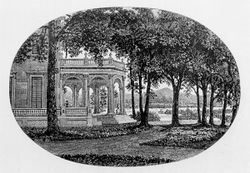
- Downing, A. J., October 1847, "A Visit to Montgomery Place," describing Montgomery Place, country home of Mrs. Edward (Louise) Livingston, Dutchess County, N.Y. (Horticulturist 2: 157) [20]
- "He takes another path, passes by an airy looking rustic bridge, and plunging for a moment into the thicket, emerges again in full view of the first cataract. Coming from the solemn depths of the woods, he is astonished at the noise and volume of the stream, which here rushes in wild foam and confusion over the rocky fall, forty feet in depth. Ascending a flight of steps made in the precipitous banks of the stream, we have another view, which is scarcely less spirited and picturesque.
- "This waterfall, beautiful at all seasons, would alone be considered a sufficient attraction to give notoriety to a rural locality in most country neighborhoods. But as if nature had intended to lavish her gifts here, she has, in the course of this valley, given two other cataracts. These are all striking enough to be worthy of the pencil of the artist, and they make this valley a feast of wonders to the lovers of the picturesque." [Fig. 12]
- Miller, Lewis, June 5, 1849, describing Mount Vernon, plantation of George Washington, Fairfax County, Va. (c. 1850: 108), [21] back up to history
- "Mount Vernon . . . is pleasantly situated on the Virginia bank of the river. The mansion house itself appears venerable and convenient[.] A lofty portico ninety-six feet in length, Supported by Eight pillars, has a pleasing effect when viewed from the water: ornamented with little copses— clumps, and Single trees—. add a romantick and picturesque appearance to the whole Scenery." [See Fig. 3]
- Committee on the Capitol Square, Richmond City Council, July 24, 1851, describing John Notman's plans for the Capitol Square, Richmond, Va. (quoted in Greiff 1979: 162) [22]
- "It was deemed advisable to commence the improvements of the Square itself on the western side thereof . . . the ground on that side [has been] formed into gentle natural undulations, rising gradually to the base of the capitol and to the monument . . . giving great apparent extent to the grounds and producing an agreeable variety and at the same time affording space for much greater extent of walks, leading in every direction where they may be useful or agreeable without the necessity of climbing steps and dividing the grounds into irregular and picturesque lawns." [Fig. 13]
- Horticola [pseud.], March 1852, "Notes on Gardens and Country Seats Near Boston," describing Oakley Place, seat of William Pratt, Boston, Mass. (Horticulturist 7: 127) [23]
- "OAKLEY PLACE, the residence of Mrs. PRATT, is near Mr. CUSHING'S, and presents a fine specimen of a small country place, combining the picturesque and the natural—the gardenesque and the wild, in beautiful harmony together."
Citations
- Whately, Thomas, 1770, Observations on Modern Gardening ([1770] 1982: 146–47) [24]
- "Of PICTURESQUE BEAUTY.
- "XLVII. But regularity can never attain to a great share of beauty, and to none of the species called picturesque; a denomination in general expressive of excellence, but which, by being too indiscriminately applied, may be sometimes productive of errors. That a subject is recommended at least to our notice, and probably to our favour, if it has been distinguished by the pencil of an eminent painter, is indisputable; we are delighted to see those objects in the reality, which we are used to admire in the representation; and we improve upon their intrinsic merit, by recollecting their effects in the picture. The greatest beauties of nature will often suggest the remembrance; for it is the business of a landskip painter to select them; and his choice is absolutely unrestrained; he is at liberty to exclude all objects which may hurt the composition; he has the power of combining those which he admits in the most agreable manner; he can even determine the season of the year, and the hour of the day, to shew his landskip in whatever light he prefers. The works therefore of a great master, are fine exhibitions of nature, and an excellent school wherein to form a taste for beauty; but still their authority is not absolute; they must be used only as studies, not as models; for a picture and a scene in nature, though they agree in many, yet differ in some particulars, which must always be taken into consideration, before we can decide upon the circumstances which may be transferred from the one to the other.
- "In their dimensions the distinction is obvious; the same objects on different scales have very different effects; those which seem monstrous on the one, may appear diminutive on the other; and a form which is elegant in a small object, may be too delicate for a large one."
- Gilpin, William, 1792, Three Essays: On Picturesque Beauty (pp. 3–8) [25]
- "Disputes about beauty might perhaps be involved in less confusion, if a distinction were established, which certainly exists, between such objects as are beautiful, and such as are picturesque—between those, which please the eye in their natural state; and those, which please from some quality, capable of being illustrated in painting....
- "In examining the real object, we shall find, one source of beauty arises from that species of elegance, which we call smoothness, or neatness; for the terms are nearly synonymous. . . .
- "But in picturesque representation it seems somewhat odd, yet we shall perhaps find it equally true, that the reverse of this is the case; and that the ideas of neat and smooth, instead of being picturesque, in fact disqualify the object,in which they reside, from any pretensions to picturesque beauty.—Nay farther, we do not scruple to assert, that roughness forms the most essential point of difference between the beautiful, and the picturesque; as it seems to be that particular quality, which makes objects chiefly pleasing in painting.—I use the general term roughness; but properly speaking roughness relates only to the surfaces of bodies: when we speak of their delineation, we use the word ruggedness. Both ideas however equally enter into the picturesque; and both are observable in the smaller, as well as in the larger parts of nature—in the outline, and bark of a tree, as in the rude summit, and craggy sides of a mountain....
- "Turn the lawn into a piece of broken ground: plant rugged oaks instead of flowering shrubs: break the edges of the walk: give it the rudeness of a road: mark it with wheel-tracks; and scatter around a few stones, and brushwood; in a word, instead of making the whole smooth, make it rough; and you make it also picturesque."
- Price, Uvedale, 1794, An Essay on the Picturesque (pp. 17, 34) [26]
- "IT seems to me, that the neglect, which prevails in the works of modern improvers, of all that is picturesque, is owing to their exclusive attention to high polish and flowing lines, the charms of which they are so engaged in contemplating, as to make them overlook two of the most fruitful sources of human pleasure; the first, that great and universal source of pleasure, variety, whole power is independent of beauty, but without which even beauty itself soon ceases to please; the other, intricacy, a quality which, though distinct from variety, is so connected and blended with it, that the one can hardly exist without the other.
- "THERE are few words whose meaning has been less accurately determined than that of the word Picturesque."
- Anonymous, 1798, Encyclopaedia (7:565) [27]
- "II. PICTURESQUE BEAUTY. Though the aids of art are as essential to gardening, as education is to manners; yet art may do too much: she ought to be considered as the hand-maid, not as the mistress, of nature; and whether she be employed in carving a tree into the figure of an animal, or in shaping a view into the form of a picture, she is equally culpable. The nature of the place is sacred. Should this tend to landscape, form some principal point of view, assist nature and perfect it; provided this can be done without injuring the views from other points. But do not disfigure the natural features of the place:—do not sacrifice its native beauties, to the arbitrary laws of landscape painting. . . .
- "Instead of sacrificing the natural beauties of the place to one formal landscape, let every step disclose fresh charms unsought for. Planting and Gardening, p. 602."
- Gregory, G., 1816, A New and Complete Dictionary of Arts and Sciences (2:n.p.), [28] back up to history
- "GARDENING. This art, so natural to man, so improving to health, so conducive to the comforts and the best luxuries of life, may properly be divided into two branches; practical, and picturesque or landscape gardening.
- "The former is what every person, except the inhabitants of populous cities, has more or less occasion to practise; the latter is a privilege which only the very opulent can enjoy, and which must consequently be the elegant amusement of a chosen few.
- "Picturesque or landscape gardening should certainly never be attempted on a small scale. Indeed we are not certain that we may not be incurring a solecism in applying the term gardening to this department of agriculture. It is properly the art of laying out grounds; and the park or the farm, not the garden, is its object. It never can be attempted with success on a smaller scale than 20 acres; but 50 or 100, or even more, are better adapted to the design.
- "That style of gardening which would unite both objects, and which would give a picturesque effect to an acre or two of ground, is truly absurd. Many an improvident citizen wastes unprofitably the morsel of earth which should grow cabbages for his family, on an unprofitable grass-plat or shrubbery, on serpentines and mazes, and fishponds; or even on cascades, to the infinite annoyance of his visitors, the prejudice of his own health, and the merriment of all persons of true taste. This mania for the picturesque would have been not less deserving the ridicule of an Addison, than the perverse taste which displayed our first parents in yew, and the Graces and Muses in Portugal laurel. . . .
- "Picturesque gardening is effected by a number of means which a true rural genius, and the study of examples, only can produce. These examples may be pictures, but the better instructors will be scenes in nature; and the proper grouping of trees, according to their mode of growth, shades of green, and appearance in autumn, will effect a great deal.
- "To plant picturesquely, a knowledge of the characteristic differences of trees and shrubs, is evidently a principle qualification. Some trees spread their branches wide, others grow spiral, and some conical; some have a close foliage, others an open one; and some form regular, others irregular heads, the branches and leaves of which may grow erect, level, or pendant."
- Loudon, J. C., 1826, An Encyclopaedia of Gardening (p. 1000), [29] back up to history
- "7180. As an illustration of the theory of landscape-gardening, which we have adopted, we subjoin a slight analysis of the principles of a composition, expressive of picturesque and natural beauty. For this purpose, it is a matter of indifference, as far as respects picturesque beauty, whether we choose a real or painted landscape; but, as we mean also to investigate its poetic or general beauty, we shall prefer a reality. We choose then a perfect flat, varied by wood, say elms, with a piece of water, and a high wall, forming the angle of a ruined building; it is animated by cows and sheep; its expression is that of melancholy grandeur; and, independently of this beauty, it is picturesque in expression; that is, if painted it would form a tolerable picture."
- Parmentier, André, 1828, The New American Gardener (quoted in Fessenden 1828: 185) [30]
- "For where can we find an individual, sensible to the beauties and charms of nature, who would prefer a symmetric garden to one in modern taste; who would not prefer to walk in a plantation irregular and picturesque, rather than in those straight and monotonous alleys, bordered with mournful box, the resort of noxious insects?"
- Anonymous, January 4, 1828, "Rural Scenery" (New England Farmer 6: 187) [31]
- "Landscape and Picturesque Gardens.—Among the embellishments which attend the increase of wealth, the cultivation of the sciences, and the refinement of taste, none diversify and heighten the beauty of rural scenery, more than picturesque and landscape gardens. . . .
- "For the introduction into this country of the design and execution of landscape and picturesque gardening, the public is much indebted to Mr. A. Parmentier, proprietor of the Horticultural Botanic Garden, near Brooklyn, two miles from this city. His own garden, for which he made so advantageous a choice, may give us some idea of his taste. The borders are composed of every variety of trees and shrubs that are found in his nurseries. The walks are sinuous, adapted to the irregularity of the ground, and affording to visitors a continual change of scenery, which is not enjoyed in gardens laid out in even surfaces, and in right lines. His dwelling and French saloon are in accordance with the surrounding rural aspect. In his gardens are 25,000 vines planted and arranged in the manner of the vineyards of France."
- Dearborn, H.A.S., September 19, 1829, An Address Delivered Before the Massachusetts Horticultural Society (1833: 16) [32]
- "The natural divisions of Horticulture are the Kitchen Garden, Seminary, Nursery, Fruit Trees and Vines, Flowers and Green Houses, the Botanical and Medical Garden, and Landscape, or Picturesque Gardening."
- Anonymous, April 1, 1837, "Landscape Gardening" (Horticultural Register 3: 124–25), [33] back up to history
- "Confining ourselves to the modern or natural style, we shall proceed to offer some remarks on its characteristics. Landscape gardens in this style generally present either picturesque, or what is termed gardenesque scenery. Picturesque scenery is a facsimile imitation of natural scenery; the trees and shrubs constituting it are planted, as in natural forests and forest-groups, such as a painter would wish to copy; every appearance of art is concealed, and it exactly resembles a real landscape, except in the greater variety and profusion of pleasing assemblages within a smaller space than can be found in nature. Its effect as a whole, only, is studied. . . . The picturesque is calculated to please particularly the admirers of landscape scenery in nature; the gardenesque not only these, but the florist and botanist also. ...In picturesque scenery, the trees may be allowed to grow thick or irregular, provided they form an agreeable collective effect; but in the gardenesque, every thing irregular or rough should be removed, which would prevent a neat and finished appearance."
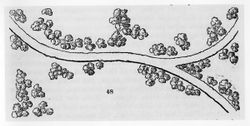
- Loudon, J. C., 1838, The Suburban Gardener (pp. 164–66) [34]
- "Picturesque Imitation. To design and execute a scene in either of these styles of imitative art, the artist would require to have the eye of a landscape-painter; to a certain extent, the science of an architect and of a botanist; and the knowledge of a horticulturist. Every part of nature, whether rude or refined, may be imitated according to art. For example, an old gravel pit, which had become covered with bushes and indigenous trees, and contained a hovel or rude cottage in the bottom, with a natural path worn in the grass by the occupants, would be improved according to imitative art, if foreign trees, shrubs, and plants, even to the grasses, were introduced instead of indigenous ones; and a Swiss cottage, or an architectural cottage of any kind that would not be recognised as the common cottage of the country, substituted for the hovel. To complete the character of art, the walk should be formed and gravelled, at least, to such an extent as to prevent its being mistaken for a natural path. Rocky scenery, aquatic scenery, dale or dingle scenery, forest scenery, copse scenery, and open glade scenery, may all be imitated on the same principle; viz. that of substituting foreign for indigenous vegetation, and laying out artificial walks. This is sufficient to constitute a picturesque imitation of natural scenery. . . .
- "In fig. 47. the trees are arranged in the gardenesque manner; and in fig. 48., in the picturesque style. The same character is also communicated to the walks; that in the gardenesque style, having the margins definite and smooth, while the picturesque walk has the edge indefinite and rough. Utility requires that the gravel, in both styles of walk, should be smooth, firm, and dry; for it must always be borne in mind, that, as landscape-gardening is a useful as well as an agreeable art, no beauty must ever be allowed to interfere with the former quality. [Fig. 14]
- "In planting, thinning, and pruning, in order to produce gardenesque effect, the beauty of every individual tree and shrub, as a single object, is tobe taken into consideration, as well as the beauty of the mass: while in planting, thinning, and pruning for picturesque effect, the beauty of individual trees and shrubs is of little consequence; because no tree or shrub, in a picturesque plantation or scene, should stand isolated, and each should be considered as merely forming part of a group or mass. In a picturesque imitation of nature, the trees and shrubs, when planted, should be scattered over the ground in the most irregular manner; both in their disposition with reference to their immediate effect as plants, and with reference to their future effect as trees and shrubs. In some places trees should prevail, in others shrubs; in some parts the plantation should be thick, in others it should be thin; two or three trees, or a tree and shrub, ought often to be planted in one hole, and this more especially on lawns."
- Downing, A. J., February 1848, "Hints and Designs for Rustic Buildings" (Horticulturist 2: 363–64) [35]
- "But the more humble and simple cottage grounds, the rural walks of the ferme ornée, and the modest garden of the suburban amateur, have also their ornamental objects and rural buildings—in their place, as charming and spirited as the more artistical embellishments which surround the palladian villa.
- "These are the seats, bowers, grottoes, and arbors, of rustic work—than which nothing can be more easily and economically constructed, nor can add more to the rural or picturesque expression of the scene.
- "Those simple buildings, often constructed only of a few logs and twisted limbs of trees, are in good keeping with the simplest or the grandest forms of nature. . . . The terminus of a long walk, otherwise unmeaning, is in no way more easily rendered satisfactory and agreeable, than by a picturesque place of repose; and the charms of a commanding hill, where the eye wanders over a grand panorama, is rarely so happily improved, as by being crowned with a rustic pavilion, which seems as the shelter and resting place of modern Gilpins, 'in search of the picturesque.'"
- Elder, Walter, 1849, The Cottage Garden of America (p. 26) [36]
- "If [the rich gentleman's lawn is constructed] in the picturesque style, the trees will stand in groups, contrasting the sizes and colours of their foliage, commingling, and making a harmonious whole."
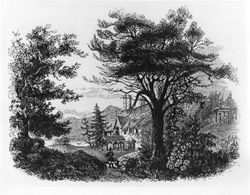
- Downing, A. J., 1849, A Treatise on the Theory and Practice of Landscape Gardening (pp. 63, 69, 74, 142, 182, 193, 270, 352, 443–44), [37] back up to history
- "The earliest professors of Modern Landscape Gardening have generally agreed upon two variations, of which the art is capable. . . . These are the beautiful and the picturesque: or, to speak more definitely, the beauty characterized by simple and flowing forms, and that expressed by striking, irregular, spirited forms. . . .
- "More concisely, the Beautiful is nature or art obeying the universal laws of perfect existence (i.e. Beauty), easily, freely, harmoniously, and without the display of power. The Picturesque is nature or art obeying the same laws rudely, violently, irregularly, and often displaying power only. . . .
- "THE PICTURESQUE in Landscape Gardening. . .aims at the production of outlines of a certain spirited irregularity, surfaces comparatively abrupt and broken, and growth of a somewhat wild and bold character. The shape of the ground sought after, has its occasional smoothness varied by sudden variations, and in parts runs into dingles, rocky groups, and broken banks. The trees should in many places be old and irregular. . . . [Fig. 15]

- "In Picturesque plantations everything depends on intricacy and irregularity, and grouping, therefore, must often be done in the most irregular manner— rarely, if ever, with single specimens, as every object should seem to connect itself with something else; but most frequently there should be irregular groups, occasionally running into thickets, and always more or less touching each other; trusting to after time for any thinning, should it be necessary. Fig. 22 may. . .give an idea of picturesque grouping. . . . [Fig. 16]
- "The oak is not only one of the grandest and most picturesque objects as a single tree upon a lawn, but it is equally unrivalled for groups and masses. There is a breadth about the lights and shadows reflected and embosomed in its foliage, a singular freedom and boldness in its outline, and a pleasing richness and intricacy in its huge ramification of branch and limb, that render it highly adapted to these purposes. . . .
- "Like the lime tree, however, care must be taken, in the modern style, to introduce it [the Horsechestnut] rather sparingly in picturesque plantations, and then only as a single tree, or upon the margin of large groups, masses, or plantations; but it may be more freely used in grounds in the graceful style, for which it is highly suitable. . . .
- "In bold or picturesque scenes, they [the maple] can be employed to advantage by intermingling them with the more striking and majestic forms of the oak, etc., where variety and contrast is desired. . . .
- "This purpose may be either to give spirit to a group of other trees, to strengthen the already picturesque character of a scene, or to give life and variety to one naturally tame and uninteresting. All these objects can be fully effected by the Larch; and although it is by far the most suited to harmonize with and strengthen the expression of scenery naturally grand, or picturesque, with which it most readily enters into combination; yet, in the hands of taste, there can be no reason why so marked a tree should not be employed in giving additional expression to scenery of a tamer character. . . .
- "we have already rejected all regular and geometric forms, in scenes where either natural or picturesque beauty is supposed to predominate, . . .
- "There are two method of grouping shrubs upon lawns which may separately be considered, in combination with beautiful and with picturesque scenery.
- "In the first case, where the character of the scene, of the plantations of trees, etc., is that of polished beauty, the belts of shrubs may be arranged similar to herbaceous flowering plants, in arabesque beds, along the walks. . . In this case, the shrubs alone, arranged with relation to their height, may occupy the beds; or if preferred, shrubs and flowers may be intermingled. . . .
- "Where picturesque effect is the object aimed at in the pleasure-grounds, it may be attained in another way; that is, by planting irregular groups of the most vigorous and thrifty growing shrubs in lawn, without placing them in regular dug beds or belts; but instead of this, keeping the grass from growing and the soil somewhat loose, for a few inches round their stems. . . .
- "As in picturesque scenes everything depends upon grouping well, it will be found that shrubs may be employed with excellent effect in connecting single trees, or finishing a group composed of large trees, or giving fullness to groups of tall trees newly planted on a lawn, or effecting a union between buildings and ground. It is true that it requires something of an artist’s feeling and perception of the picturesque to do these successfully, but the result is so much the more pleasing and satisfactory when it is well executed.
- "When walks are continued from the house through distant parts of the pleasure-grounds, groups of shrubs may be planted along their margins, here and there, with excellent effect. They do not shut out or obstruct the view like large trees, while they impart an interest to an otherwise tame and spiritless walk."
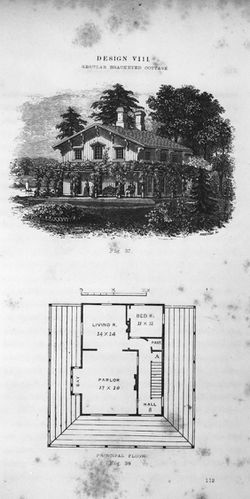
- Jeffreys [pseud.], December 1849, "Critique on the October Horticulturist" (Horticulturist 4: 271)
- "River's Nursery—No doubt a most interesting and beautiful sight. I have often wondered why our nurserymen, many of them men of fine taste in landscape delineation, do not study more of the beautiful, and the picturesque in laying out and planting their grounds. Such dispositions may be made of the different fruit and ornamental trees, shrubbery, and flowering plants, as would make them exceedingly attractive as places of resort, and thereby greatly extend the sales to their proprietors. Let us have a reform in these things, and not have our nurseries, as too many of them now do, look like so many corn-fields or bean patches; but tasteful, inviting, and expressive in part of the purpose for which the plants with which they are occupied, are intended. IT is one most interesting feature of this truly delightful profession, that our nurserymen now embrace many men of education, taste and refinement. Let this improvement continue, and by their annual congregation in conventions, and mutual and friendly intercourse, they will ere long arrive at that position which their useful calling should command."
- Downing, A. J., 1850, The Architecture of Country Houses ([1850] 1968: 112–13, 344) [38] back up to discussion
"In the Design before us, Fig. 37, there is an air of rustic or rural beauty conferred on the whole cottage by the simple, or veranda-like arbor, or trellis, which runs round three sides of the building; as well as an expression of picturesqueness, by the roof supported on ornamental brackets and casting deep shadows upon the walls.
"To become aware how much this beauty of expression has to do with rendering this cottage interesting, we have only to imagine it stripped of the arbor-veranda and the projecting eaves, and it becomes in appearance only the most meagre and common-place building, which may be a house or a barn: at the most, it would indicate nothing more by its chimneys and windows, than that it is a human habitation, and not, as at present, that it is the dwelling of a family who have some rural taste, and some love for picturesque character in a house. . . .
- "It is in such picturesque scenery as this— scenery which exists in many spots in America besides the banks of the Hudson—wherever, indeed, the wildness or grandeur of nature triumphs strongly over cultivated landscape—but especially where river or lake and hill country are combined—it is there that the highly picturesque country-house or villa, is instinctively felt to harmonize with and belong to the landscape. It is there that the high tower, the steep roof, and the boldly varied outline, seem wholly in keeping with the landscape, because these forms in the building harmonize either by contrast or assimilation, with the pervading spirit of mysterious power and beauty in romantic scenery." [Fig. 17]
Images
Inscribed
J. C. Loudon, Trees arranged in the picturesque style, in The Suburban Gardener (1838), p. 165, fig. 48.
Robert Mills, Picturesque View of the Building, and Grounds in front, 1841.
Lewis Miller, "Mount Vernon" [detail], in Orbis Pictus (c. 1849), p. 108. "ornamented with little copses—clumps and single trees.—add a romantick and picturesque appearance to the whole scenery"
Anonymous, "Grouping to produce the Picturesque," in A. J. Downing, A Treatise on the Theory and Practice of Landscape Gardening (1849), p. 103, fig. 22.
Anonymous, "Plan of a Suburban Villa Residence," in A. J. Downing, A Treatise on the Theory and Practice of Landscape Gardening (1849), p. 118, fig. 26. "At e, is a picturesque orchard"
Anonymous, "View of a Picturesque farm (ferme ornée)," in A. J. Downing, A Treatise on the Theory and Practice of Landscape Gardening (1849), p. 120, fig. 27.
Anonymous, "Example of the Picturesque in Landscape Gardening", in A. J. Downing, A Treatise on the Theory and Practice of Landscape Gardening (1849), pl. opp. p. 273, fig. 16.
Associated
Thomas Birch, Fairmount Water Works, 1821.
Daniel Wadsworth, "Monte-Video," in Benjamin Silliman, Remarks Made on a Short Tour between Hartford and Quebec (1824), frontispiece.
Daniel Wadsworth, "Monte Video, Approach to the House," in Benjamin Silliman, Remarks Made on a Short Tour between Hartford and Quebec (1824), pl. opp. p. 16.
Thomas Doughty, View of the Fairmount Waterworks, Philadelphia, from the Opposite of the Schuylkill River, c. 1824-26.
Robert Mills, Alternative plan for the grounds of the National Institution, 1841.
Anonymous, "Mrs. Camac's Residence," in A. J. Downing, ed., Horticulturist 1, no. 5 (November 1846): pl. opp. p. 201, fig. 56.
Anonymous, Two Ornamental Ice Houses Above Ground, in A. J. Downing, ed., Horticulturist 1, no. 6 (December 1846): pl. opp. p. 249.
Alexander Jackson Davis, "Montgomery Place," in A. J. Downing, ed., Horticulturist 2, no. 4 (October 1847): pl. opp. p. 153.
James Smillie, "Mount Auburn Cemetery," in Cornelia W. Walter, Mount Auburn Illustrated ([1847] 1850), frontispiece.
James Smillie (artist), J. A. Rolph (etcher), "View of the Forest Pond, Mount Auburn Cemetery," in Cornelia W. Walter, Mount Auburn Illustrated ([1847] 1850), opp. p. 94.
Alexander Jackson Davis, "View in the Grounds at Blithewood," in A. J. Downing, A Treatise on the Theory and Practice of Landscape Gardening (1849), frontispiece.
Anonymous, "Kenwood, Residence of J. Rathbone, Esq. near Albany, N.Y.," in A. J. Downing, A Treatise on the Theory and Practice of Landscape Gardening (1849), pl. opp. p. 50, fig. 9.
Anonymous, "Cottage Residence of Wm. H. Aspinwall, Esq.," in A. J. Downing, A Treatise on the Theory and Practice of Landscape Gardening (1849), pl. opp. p. 51, fig. 8.
Anonymous, "Plan of a Mansion Residence, laid out in the natural style," in A. J. Downing, A Treatise on the Theory and Practice of Landscape Gardening (1849), p. 115, fig. 25.
Anonymous, "Rustic prospect-arbor," in A. J. Downing, A Treatise on the Theory and Practice of Landscape Gardening (1849), p. 460, fig. 87.
Anonymous, "Small Bracketed Cottage," in A. J. Downing, The Architecture of Country Houses (1850), pl. opp. p. 78, fig. 9.
Anonymous, "Regular Bracketed Cottage," in A. J. Downing, The Architecture of Country Houses (1850), pl. opp. p. 112, figs. 37 and 38.
Anonymous, "Design for a Cottage for a Country Clergyman," in A. J. Downing, ed., Horticulturist 6, no. 7 (July 1851): pl. opp. p. 297.
Thomas Chambers, Mount Auburn Cemetery, mid-19th century.
Attributed
Benjamin Henry Latrobe, View of Mount Vernon looking towards the South West, 1796.
William Groombridge, View of Lemon Hill, c. 1800.
George Inness, Sunnyside, c. 1850–60.
Notes
- ↑ A. J. Downing, A Treatise on the Theory and Practice of Landscape Gardening, 4th edn. (New York: G. P. Putnam, 1849), 103, view on Zotero.
- ↑ The Virginia Journals of Benjamin Henry Latrobe, 1795–1798, ed. Edward C. Carter II (New Haven, Conn.: Yale University Press, 1977), 1:165, view on Zotero.
- ↑ William Bartram, Travels, and Other Writings (New York: Library of America, 1996), view on Zotero.
- ↑ Charles Brockden Brown, Wieland, or The Transformation, An American Tale (New York: T. & J. Swords, 1798), view on Zotero.
- ↑ William Parker Cutler, Life, Journals, and Correspondence of Rev. Manasseh Cutler, LL. D (Athens, Ohio: Ohio University Press, 1987), view on Zotero.
- ↑ Philip Lee Phillips, The Beginnings of Washington: As Described in Books, Maps, and Views (Washington, D.C.: The author, 1917), view on Zotero.
- ↑ Benjamin Silliman, Remarks Made on a Short Tour between Hartford and Quebec, in the Autumn of 1819 (New Haven, Conn.: S. Converse, 1824), view on Zotero.
- ↑ Anonymous, "On Landscape and Picturesque Gardens," The New England Farmer and Horticultural Journal 4, no. 40 (April 28, 1826): 316, view on Zotero.
- ↑ Alice B. Lockwood, ed., Gardens of Colony and State: Gardens and Gardeners of the American Colonies and of the Republic before 1840, 2 vols. (New York: Charles Scribner’s for the Garden Club of America, 1931-34), view on Zotero.
- ↑ Anonymous, "Parmentier's Horticultural Garden," The New England Farmer and Horticultural Journal 7, no. 11 (October 3, 1828): 84–85, view on Zotero.
- ↑ James Boyd, A History of the Pennsylvania Horticultural Society, 1827-1927 (Philadelphia: Pennsylvania Horticultural Society, 1929), view on Zotero.
- ↑ Thaddeus William Harris, A Discourse Delivered before the Massachusetts Horticultural Society on the Celebration of Its Fourth Anniversary, October 3, 1832 (Cambridge, Mass.: E. W. Metcalf, 1832), view on Zotero.
- ↑ Constance Weber, "A Sketch of Joseph Bonaparte," in Godey’s Lady's Book (Philadelphia: L. A. Godey, 1854), view on Zotero.
- ↑ Nathaniel Parker Willis, American Scenery, or Land, Lake and River Illustrations of Transatlantic Nature, 2 vols. (Barre, Mass.: Imprint Society, 1971), view on Zotero.
- ↑ Pamela Scott, ed., The Papers of Robert Mills (Wilmington, Del.: Scholarly Resources, 1990),view on Zotero.
- ↑ Charles Mason Hovey, "Notes Made during a Visit to New York, Philadelphia, Baltimore, and Washington, and Intermediate Places, from August 8th to the 23rd, 1841," The Magazine of Horticulture, Botany, and All Useful Discoveries and Improvements in Rural Affairs 7, no. 10 (October 1841): 361–74, view on Zotero.
- ↑ Nehemiah Adams, Boston Common (Boston: William D. Ticknor and H. B. Williams, 1842), view on Zotero.
- ↑ W., "An Account of the Lowell Cemetery, Its Situation, Historical Associations, and Particular Description," The Magazine of Horticulture, Botany, and All Useful Discoveries and Improvements in Rural Affairs 8, no. 2 (February 1842): 47–50, view on Zotero.
- ↑ John Warner Barber, and Henry Howe, Historical Collections of the State of New Jersey; Containing a General Collection of the Most Interesting Facts, Traditions, Biographical Sketches, Anecdotes, &c. Relating to History and Antiquities, with Geographical Descriptions of Every Township in the State (Newark, N.J.: Benjamin Olds, 1844), view on Zotero.
- ↑ Alexander Jackson Downing, ed., "A Visit to Montgomery Place," The Horticulturist and Journal of Rural Art and Rural Taste 2, no. 4 (October 1847): 153–60 view on Zotero.
- ↑ Lewis Miller, Orbis Pictus: A Picturesque Album to the Ladies of York, Pennsylvania (Williamsburg, Va.: Abby Aldrich Rockefeller Folk Art Center, Colonial Williamsburg Foundation, 1850), view on Zotero.
- ↑ Constance Greif, John Notman, Architect, 1810-1865 (Philadelphia: Athenaeum of Philadelphia, 1979), view on Zotero.
- ↑ Horticola [pseud.], "Notes on Gardens and Country Seats near Boston," The Horticulturist and Journal of Rural Art and Rural Taste 7, no. 3 (March 1852): 126–28, view on Zotero.
- ↑ Thomas Whately, Observations on Modern Gardening, 3rd edn (London: Garland, 1982), view on Zotero.
- ↑ William Gilpin, Three Essays: On Picturesque Beauty; On Picturesque Travel; and On Sketching Landscape: To Which Is Added a Poem on Landscape Painting (Farnborough, England: Gregg, 1972), view on Zotero.
- ↑ Uvedale Price, Essays on the Picturesque as Compared with the Sublime and the Beautiful (London: J. Robson, 1794), view on Zotero.
- ↑ Encyclopaedia, or A Dictionary of Arts, Sciences, and Miscellaneous Literature, 18 vols. (Philadelphia: Thomas Dobson, 1798), view on Zotero.
- ↑ George Gregory, A New and Complete Dictionary of Arts and Sciences, First American, from the second London edition, considerably improved and augmented, 3 vols. (Philadelphia: Isaac Peirce, 1816), vol. 2, view on Zotero.
- ↑ J. C. (John Claudius) Loudon, An Encyclopaedia of Gardening; Comprising the Theory and Practice of Horticulture, Floriculture, Arboriculture, and Landscape-Gardening, 4th edn. (London: Longman et al, 1826), view on Zotero.
- ↑ Thomas Fessenden, ed., The New American Gardener, 1st edn. (Boston: J. B. Russell, 1828), view on Zotero.
- ↑ Anonymous, "Rural Scenery," The New England Farmer and Horticultural Journal 6, no. 24 (January 4, 1828): 187, view on Zotero.
- ↑ H.A.S. (Henry Alexander Scammell) Dearborn, An Address Delivered before the Massachusetts Horticultural Society (Boston: J.T. Buckingham, 1833), view on Zotero.
- ↑ Anonymous, "Landscape Gardening," The Horticultural Register and Gardener's Magazine 3 (April 1, 1837): 121–31, view on Zotero.
- ↑ J. C. (John Claudius) Loudon, The Suburban Gardener, and Villa Companion (London: Longman et al, 1838), view on Zotero.
- ↑ Anonymous, "Hints and Designs for Rustic Buildings," The Horticulturist and Journal of Rural Art and Rural Taste 2, no. 8 (February 1848): 363–65, view on Zotero.
- ↑ Walter Elder, The Cottage Garden of America (Philadelphia: Moss, 1849), view on Zotero.
- ↑ A. J. [Andrew Jackson] Downing, A Treatise on the Theory and Practice of Landscape Gardening, Adapted to North America, 4th edn. (Washington, D.C.: Dumbarton Oaks Research Library and Collection, 1991), view on Zotero.
- ↑ A. J. [Andrew Jackson] Downing, The Architecture of Country Houses; Including Designs for Cottages, Farm-Houses, and Villas (Originally published New York; Reprint, New York: D. Appleton; Da Capo, 1968), view on Zotero.

